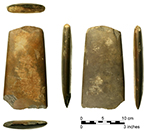New information from an old stone adze found in Pohnpei
- Details
- Category: News
- Published: Monday, 30 November -0001 00:00
- Written by Bill Jaynes
- Hits: 357
Dr. Takuya Nagaoka (NGO Pasifika Renaissance)
Professor Peter J. Sheppard (University of Auckland)
 Do you know where the first Pohnpeian people came from? According to recent archaeological, linguistic, and DNA studies, the ancestors of Pacific islanders departed from Taiwan 5,000 years ago and reached Melanesia 3,200 years ago. Then they probably migrated from the southeast Solomon Islands-northern Vanuatu region to Pohnpei around 2,000 years ago, as some Pohnpeian legends also narrate early migrations from the south. To add new evidence on ancient Pohnpeian people’s movement at that time, we have just published an academic article in “The Journal of Island and Coastal Archaeology” that reports a stone adze (“sile” in Pohnpeian) found in Pohnpei was brought by early settlers or their immediate descendants from Melanesia, probably New Guinea, based on our geological analysis.
Do you know where the first Pohnpeian people came from? According to recent archaeological, linguistic, and DNA studies, the ancestors of Pacific islanders departed from Taiwan 5,000 years ago and reached Melanesia 3,200 years ago. Then they probably migrated from the southeast Solomon Islands-northern Vanuatu region to Pohnpei around 2,000 years ago, as some Pohnpeian legends also narrate early migrations from the south. To add new evidence on ancient Pohnpeian people’s movement at that time, we have just published an academic article in “The Journal of Island and Coastal Archaeology” that reports a stone adze (“sile” in Pohnpeian) found in Pohnpei was brought by early settlers or their immediate descendants from Melanesia, probably New Guinea, based on our geological analysis.
In 1977, the late Miquel Marquez, a member of the Ponape Historic Preservation Committee, found a stone adze in a pile of coral sand uploaded from a truck at the construction site of the new Awak Elementary School. The sand was brought from an underwater dredging site at Mesihsou, Madolenihmw. An American archaeologist, Dr. Steve Athens, published an academic article about this discovery in 1981 but reported it was made from local basalt rock.
Since ancient Pohnpeian people mostly made adzes from giant clams and other shells, hundreds of shell adzes were found at archaeological sites around Pohnpei. In contrast, stone adzes are very rare; only 13 examples were found so far and some of them were possibly brought from Melanesia and west Polynesia according to their shapes. The recent technical development in archaeological analyses in sourcing such ancient artifacts as stone adzes, volcanic glasses, and pottery has demonstrated that Pacific islanders voyaged around islands very extensively before European contact.
So, wondering about the origin of this rare stone adze from Mesihsou, we loaned the adze to conduct a detailed analysis on it at the University of Auckland in 2006, where Nagaoka was studying for his Ph.D. According to geological observation by several experts, it is not basalt but metamorphic rock, more specifically schist, which is not present in Pohnpei and Micronesia but in Melanesia. We conclude that New Guinea is the closest and most probable source of this adze. This result shows the adze was brought over 800 miles (1,300 km) and is the first artifact found in Micronesia that is scientifically believed to be transported from Melanesia.
This finding gives us some valuable insights. First, the find spot on a shallow reef on the coast suggests that it was recovered from a very early settlement site of around 2000 years ago when the immigrants or their immediate descendants still had a connection with their homeland in Melanesia.
Second, the settlement of previously uninhabited central and eastern Micronesia (Chuuk, Pohnpei, Kosrae, the Marshalls, Kiribati) was achieved through intensive long-distance voyages, probably including two-way voyages between their homeland in Melanesia and newly settled Islands in Micronesia and among the latter islands.
Third, since a rare stone adze was probably a trading item, which required a long-distance voyage to obtain it, only limited persons in a community could access to it. In this circumstance, the large Mesihsou adze (7.5 inches/19 cm long) may have functioned as a status symbol.
Thus, the analysis of this stone adze provides us with important information for understanding the early Pohnpeian people’s movements during the largely unknown colonization period. Kalahngan en kupwuromwail for the Pohnpei State Historic Preservation Office’s staff (especially the late Jason Lebehn) and other people who assisted us in this project! (If you like to have a PDF version of the article, please email This email address is being protected from spambots. You need JavaScript enabled to view it..)






